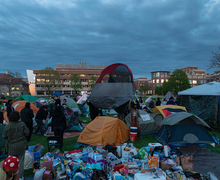Saffren: SA members must work with constituents to address home college issues, social concerns
On April 1, members of the Student Association went into an executive session to air their grievances and vote on President Allie Curtis’ impeachment. The session was supposed to re-establish transparency as the virtue of an organization that exists solely to represent the interests of Syracuse University students.
In the spirit of open communication, SA slammed its doors to non-affiliated students.
This is common procedure for executive sessions, which “are kept strictly confidential to protect the right to privacy of the members concerned,” according to SA’s press release made public April 3. But this was an exceptional case that called for the bending of a flexible guideline.
By not calling for SA to open its doors, Curtis proved she hasn’t learned much from a week she called “the hardest of my life” in an April 2 article by The Daily Orange.
If the representatives’ goal had been to impeach a shadowy leader, but not hang her in effigy, the closed-door policy would have been acceptable.
Instead, they voted to keep Curtis. This past Sunday, at a general assembly meeting, members weakly punished their leader with a few checks and balances that should have already been in place. Curtis can’t lead meetings for the rest of the semester and has to disclose how she will spend her $2,000 summer stipend.
Basically, it took six-plus hours and two meetings to reinforce the status quo.
Moving forward, the status quo on paper should not translate to action. SA needs to build a stronger relationship with the student body.
To SU students, their government is a cash cow. The SA Finance Board funds events, facilitates student organizations and helps cultivate a vibrant social campus.
But SA hasn’t mobilized the community around social concerns. Other than internship credits, Curtis has outlined no substantial initiatives during her three months in office.
In recent weeks, students have raised concerns about segregation and absentee academic advisors, among others. Besides the “Healing the Scars” discussion, organized by a non-SA-affiliated student, there have not been any efforts to start combating these concerns.
But these are broad concerns. There are many smaller, more specific concerns held by different communities on campus.
SA has nearly 50 representatives from different academic programs. None of them hold consistent forums with their constituents because they have no idea where to start.
To help guide its representatives, SA’s cabinet should construct the organization like Congress. Assign individual representatives to a manageable number of students from a unifying realm.
For example, a Martin J. Whitman School of Management representative should work with finance and accounting majors and an S.I. Newhouse School of Public Communications representative should work with newspaper and magazine majors.
The U.S. system works because proximity breeds camaraderie. People from the same communities are more likely to have similar concerns.
This is not to say SA won’t take a more active approach in the wake of a humbling scandal. SA may plan on taking this rare opportunity — when they have the undivided attention of the student body — to build a more conspicuous presence on campus.
But based on last week, there is nothing to suggest this transformation. Then again, how would anyone really know?
Jarrad Saffren is a junior television, radio and film and political science major. His column appears weekly. He can be contacted via email at [email protected] or on Twitter at @JarradSaff.
Published on April 10, 2013 at 1:07 am




